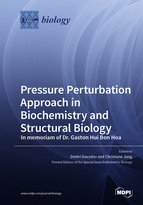Pressure Perturbation Approach in Biochemistry and Structural Biology. In memoriam of Dr. Gaston Hui Bon Hoa
A special issue of Biology (ISSN 2079-7737). This special issue belongs to the section "Biochemistry and Molecular Biology".
Deadline for manuscript submissions: closed (30 September 2021) | Viewed by 24911
Special Issue Editors
Interests: enzymology; cytochromes P450; drug metabolism; allosteric enzymes; protein–protein interactions; effects of hydrostatic pressure on proteins; piezophilic enzymes
Interests: protein biophysics; cytochromes P450; effects of hydrostatic pressure and ultrasound on biological materials; surface treatment, functionalizing, and ultrasonic cleaning of medical implants for traumatology; orthopedics; dentistry
Special Issue Information
Dear Colleagues,
This Special Issue is devoted to the effects of hydrostatic pressure on biological systems and the use of these effects for exploring the structure and function of biological macromolecules and their ensembles. Hydrostatic pressure, a fundamental thermodynamic parameter, profoundly affects the conformation of proteins and nucleic acids and biological membrane structure. It is widely used in protein biophysics and mechanistic enzymology as a tool for exploring protein conformational landscapes through displacing protein conformational equilibria and affecting protein–protein and protein–ligand interactions. Pressure perturbation spectroscopy and calorimetry complemented by ultrasound velocity measurements are indispensable for studying protein solvation and its role in enzyme functionality. Effects of hydrostatic pressure on proteins, nucleic acids, and biomembranes are also critical for understanding the mechanisms of piezophilic adaptation that allows deep-sea species (piezophiles) to survive at extreme pressures of ocean depth. In some sense, structural consequences of evolutionary adaptation to high hydrostatic pressure may be viewed as the effects of pressure perturbation imprinted in the structure of pressure-adapted biological systems.
Despite a plethora of experimental papers and a dozen fundamental reviews devoted to the effects of pressure on biological systems, this important field appears to be severely underrepresented in modern literature. We hope that this Special Issue will bring together the most important new findings and new concepts in high-pressure biosciences and promote researchers’ interest in the unique exploratory potential of the pressure perturbation approach for biochemistry, biophysics, mechanistic enzymology, and evolutionary biology.
We would like to devote this Special Issue to the memory of Gaston Hui Bon Hoa, French biophysicist, our friend and colleague, who passed away in July 2020. Gaston was one of the pioneers studying the effects of hydrostatic pressure on proteins, nucleic acids, and their assemblies. He devoted over 40 years in his scientific career to establishing pressure perturbation approaches and applying them in studies of protein structure and function. Gaston was internationally recognized as a leading expert in high-pressure biophysics.
We welcome the submission of original research, either experimental or theoretical, and review manuscripts focusing on the effects of pressure on biological macromolecules and their use in exploring the structure and function of biological systems. Manuscripts devoted to the evolutionary adaptations of deep-sea species to high hydrostatic pressure and their use in structural biology, mechanistic enzymology, and protein biophysics are also welcome.
Prof. Dr. Dmitri Davydov
PD Dr. Christiane Jung
Guest Editors
Manuscript Submission Information
Manuscripts should be submitted online at www.mdpi.com by registering and logging in to this website. Once you are registered, click here to go to the submission form. Manuscripts can be submitted until the deadline. All submissions that pass pre-check are peer-reviewed. Accepted papers will be published continuously in the journal (as soon as accepted) and will be listed together on the special issue website. Research articles, review articles as well as short communications are invited. For planned papers, a title and short abstract (about 100 words) can be sent to the Editorial Office for announcement on this website.
Submitted manuscripts should not have been published previously, nor be under consideration for publication elsewhere (except conference proceedings papers). All manuscripts are thoroughly refereed through a single-blind peer-review process. A guide for authors and other relevant information for submission of manuscripts is available on the Instructions for Authors page. Biology is an international peer-reviewed open access monthly journal published by MDPI.
Please visit the Instructions for Authors page before submitting a manuscript. The Article Processing Charge (APC) for publication in this open access journal is 2700 CHF (Swiss Francs). Submitted papers should be well formatted and use good English. Authors may use MDPI's English editing service prior to publication or during author revisions.
Keywords
- Hydrostatic pressure
- Thermodynamics
- Biochemical spectroscopy
- Conformational dynamics of biomolecules
- Protein-protein interactions
- Protein-ligand interactions
- Piezophiles
- Evolutionary adaptation








